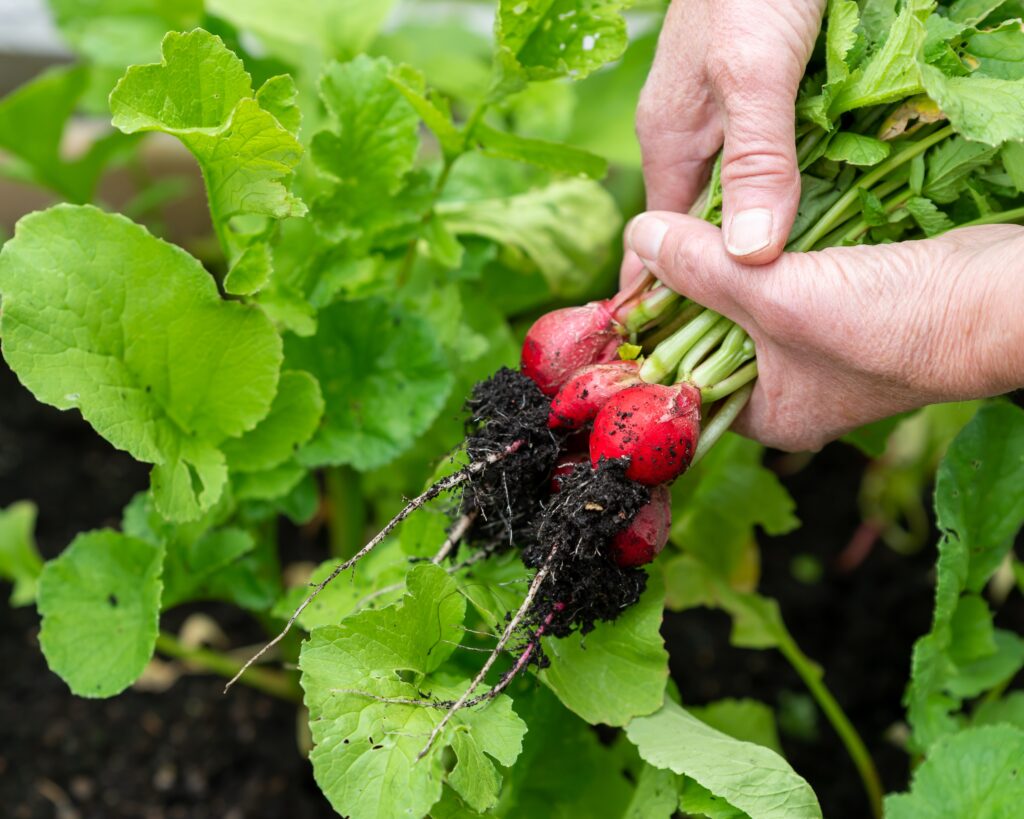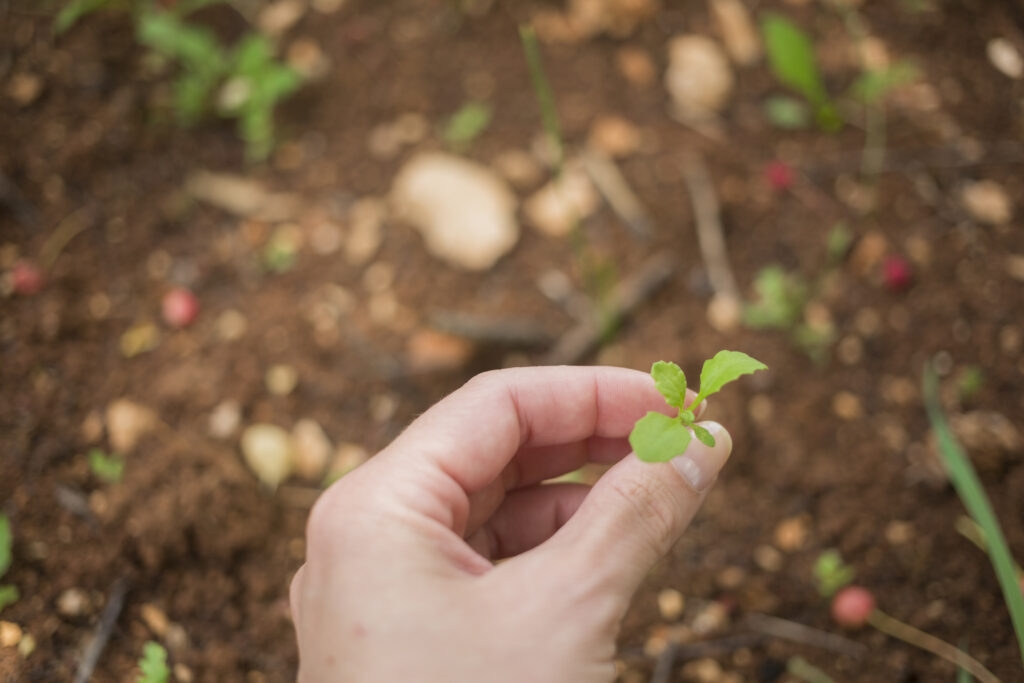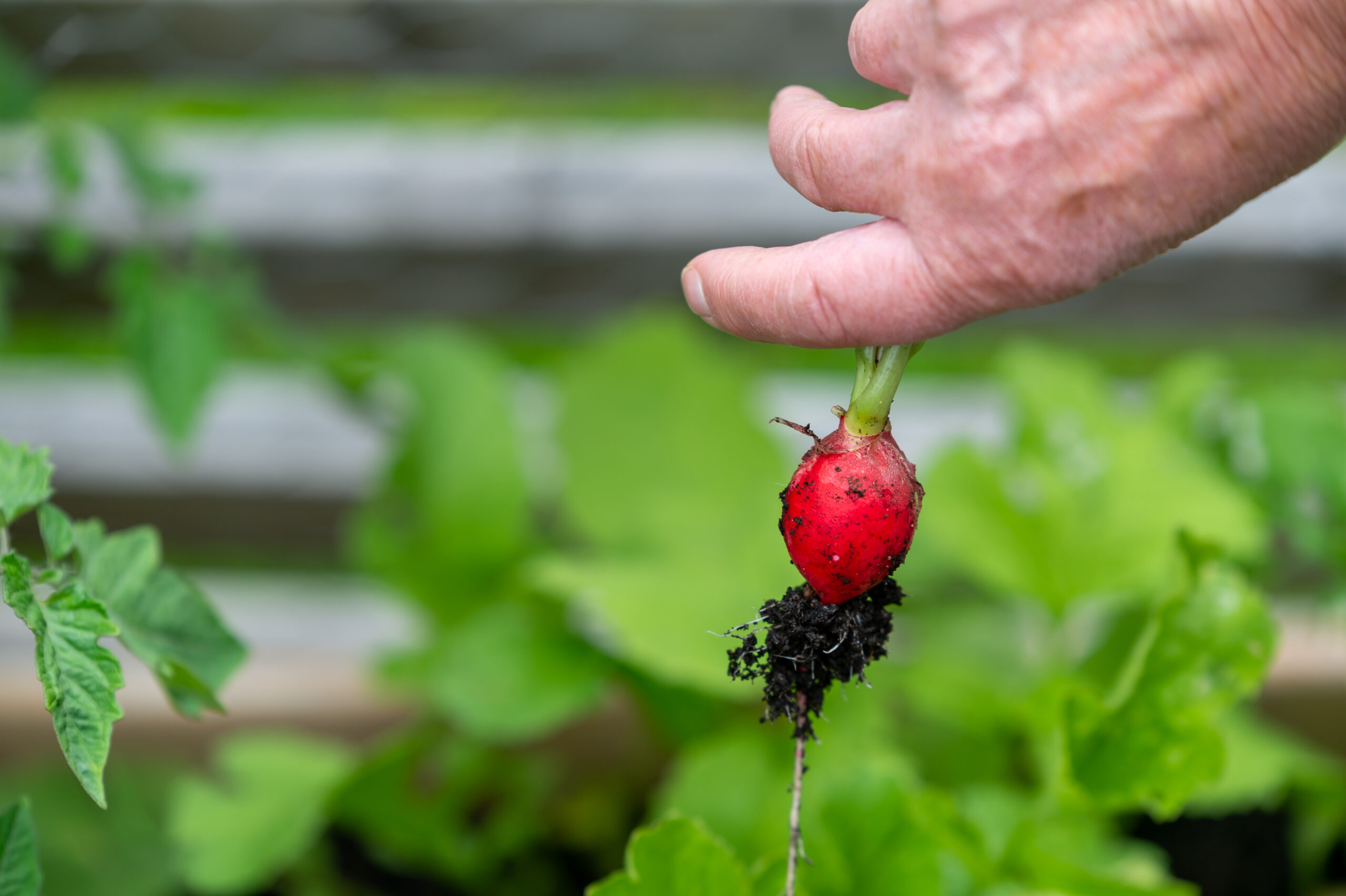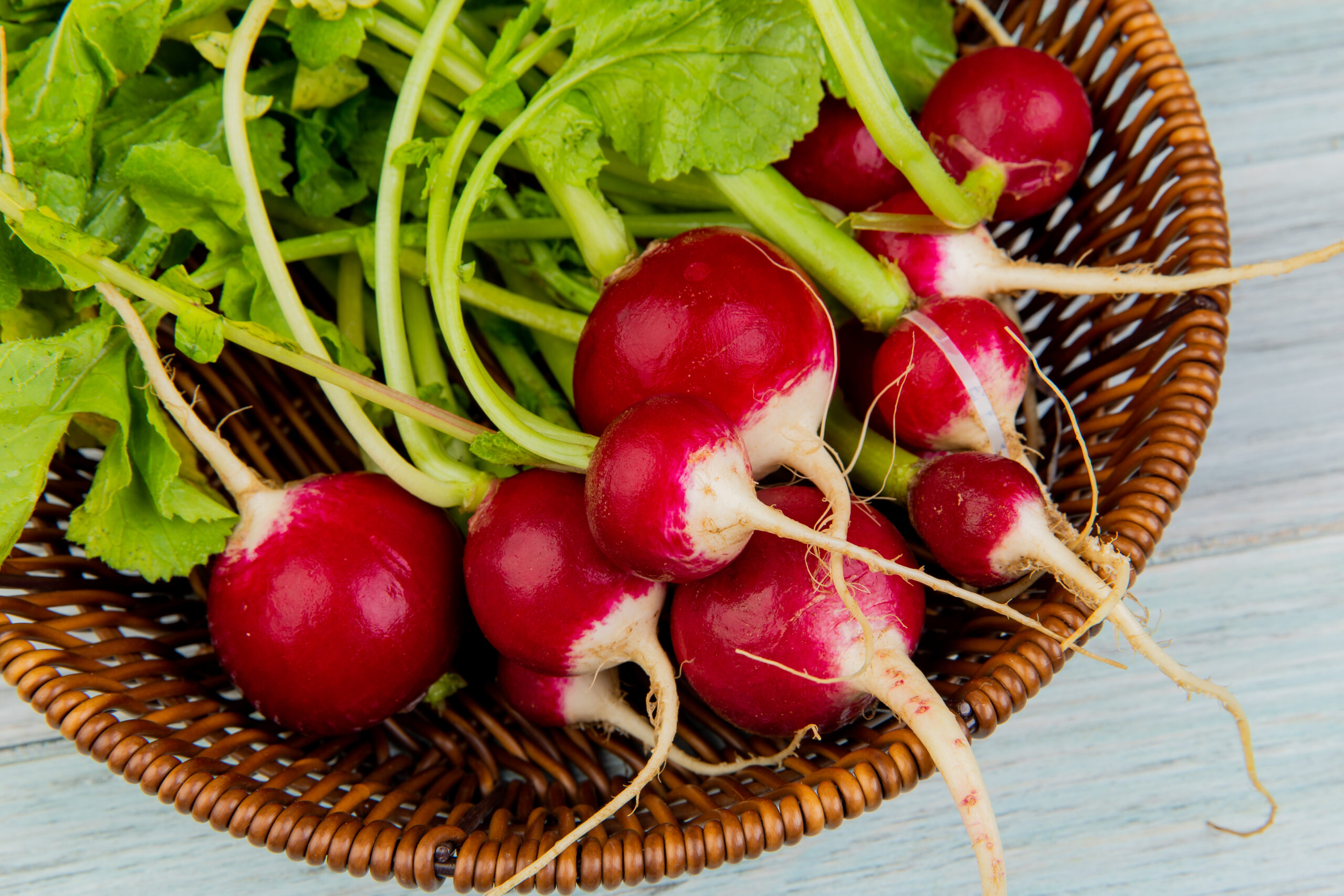How to Plant seeds of Radish?

How to Plant Seeds of Radish – If you’re looking for a quick and rewarding vegetable to grow, seeds of radish are a perfect choice. These little root veggies are incredibly easy to cultivate, making them ideal for both first-time gardeners and seasoned pros. With their fast-growing nature, radishes can go from seed to harvest in just a few weeks, giving you almost instant gratification in the garden.
In this guide, we’ll walk you through everything you need to know about planting seeds of radish, from picking the right sowing time to harvesting them at their peak flavor. Radishes thrive in cool weather, making them best suited for spring and fall planting. They grow quickly with minimal fuss, and because they don’t transplant well, it’s best to sow them directly into the soil.
Whether you have a large vegetable garden or just a small space for a container garden, seeds of radish can easily fit into your setup. With the right soil, proper spacing, and consistent care, you’ll be rewarded with crisp, flavorful radishes that add a fresh crunch to your meals. By the end of this guide, you’ll have all the tips and tricks needed to grow your own delicious radishes with confidence.
When to Plant Radish?

The right timing is essential for growing healthy radishes. These fast-growing vegetables prefer cool temperatures, which makes them best suited for spring and fall planting.
Spring Planting: Sow seeds of radish about 4–6 weeks before the last expected frost. The cool temperatures of early spring encourage steady growth, resulting in tender, flavorful radishes.
Fall Planting: For a late-season harvest, plant seeds of radish 4–6 weeks before the first expected frost. Radishes can tolerate light frost, making them a great crop for extending your gardening season.
Since radishes grow quickly, you can plant seeds of radish in succession every 7–14 days to ensure a continuous harvest throughout the season. Avoid planting radishes in hot summer months, as excessive heat can cause them to bolt and turn bitter. With proper timing, you’ll enjoy a steady supply of crisp, delicious radishes straight from your garden.
Best Temperature for Radish Growth
Radishes grow best when temperatures range between 50-70°F (10-21°C). If temperatures rise above 80°F (27°C), radishes may become tough, overly spicy, or fail to form proper bulbs.
Can You Grow Radishes in Summer?
Growing radishes in the peak summer months can be challenging due to excessive heat. High temperatures often cause radishes to bolt, leading to poor root development. If you must plant radishes in summer, choose a partially shaded location to help reduce heat stress.
In warmer climates, the best time to grow radishes is during the cooler months of fall and winter. If your region experiences mild winters, you can plant radish seeds in succession for a continuous harvest. For gardeners in colder areas, using a cold frame or greenhouse can help extend the growing season and protect your crops from extreme weather.
How to Plant Seeds of Radish ?

Step-by-Step Guide to Planting Radish Seeds
For the best results, follow these simple steps to plant seeds of radish properly:
Pick the Right Spot – Radishes grow best in loose, well-drained soil with full sun exposure. Choose an area that gets at least 6 hours of direct sunlight per day.
Prepare the Soil – Clear any weeds and loosen the soil to about 6 inches deep. Mixing in compost will improve soil fertility and drainage, giving your radishes a strong start.
Sow the Seeds – Plant the seeds of radish about ½ inch deep and 1 inch apart in rows. Lightly cover with soil and press down gently to ensure good contact.
Water Regularly – Keep the soil evenly moist, but don’t overwater. Consistent moisture helps radishes develop properly and prevents cracking.
Thin the Seedlings – Once they sprout, thin seedlings to 2 inches apart. This gives each radish enough space to grow without crowding.
Mulch for Moisture Retention – Adding a thin layer of mulch helps retain moisture, suppress weeds, and regulate soil temperature.
Minimal Fertilization Required – Radishes don’t need much feeding. A light application of balanced fertilizer before planting will support healthy growth from seed to harvest.
How Long Does It Take for Radish Seeds to Germinate?
Under ideal conditions, radish seeds will sprout in 3-5 days. Keeping the soil cool and evenly moist will help speed up germination. If you want a steady supply of fresh radishes, continue planting new seeds every 7-14 days throughout the season.
By following these simple steps, you’ll enjoy a successful radish harvest and a continuous supply of fresh, crunchy radishes from your garden!
Soil Preparation for Radishes
Radishes grow best in loose, well-draining soil that is rich in organic matter. If your soil is too compacted or heavy, it can lead to misshapen radishes and stunted growth. Proper soil preparation is crucial to ensuring a successful radish harvest.
How to Improve Soil for Radish Growth?
- Loosen the Soil – Till the soil to a depth of at least 6–8 inches to ensure proper root development and prevent stunted growth.
- Enrich with Compost – Adding organic compost improves soil fertility, aeration, and water retention, creating the ideal environment for growing radishes from seeds of radish.
- Check pH Levels – Radishes prefer slightly acidic to neutral soil, with a pH range of 5.5 to 7.0 for optimal root formation.
- Avoid Excessive Nitrogen – Using too much nitrogen-rich fertilizer can lead to lush leafy tops but poor root development, reducing the quality of your radishes.
If your garden soil is too heavy or clay-like, consider growing seeds of radish in raised beds or containers filled with a light, sandy loam soil mix. This allows for better drainage and easier root expansion, resulting in healthier radish plants.
By preparing your soil properly before planting, you’ll create the perfect conditions for fast-growing, crisp, and flavorful radishes that thrive throughout the growing season.
Radish Sowing Time

Understanding the best radish sowing time is crucial for achieving a healthy and abundant harvest. Radishes are fast-growing root vegetables that thrive in cool weather and can be grown in multiple successions throughout the growing season. The ideal time for sowing radish seeds is during the spring and fall, as extreme summer heat can cause bolting and poor root development.
For optimal growth, plant radish seeds as soon as the soil is workable in early spring, about 4-6 weeks before the last frost date. In fall, sow radish seeds approximately 4-6 weeks before the first frost for a late-season harvest. The key to a steady supply of radishes is succession planting—sowing a new batch of seeds every 7-14 days ensures a continuous harvest throughout the season.
How Often to Sow Radish Seeds?
For the best yield, radish seeds should be sown in well-prepared, loose, and well-drained soil. When planting in warmer regions, provide partial shade to prevent excessive heat stress, which can lead to bolting.
If growing radishes in containers, choose pots that are at least 6-8 inches deep to allow ample room for root development. Since container-grown radishes dry out faster than garden soil, they require consistent moisture to ensure proper growth. Regular watering helps prevent radishes from becoming tough, cracked, or overly spicy.
By following the correct radish sowing time and implementing succession planting, you can enjoy fresh, crisp radishes all season long.
When to Harvest Seeds of Radish?

One of the best things about growing radishes is how quickly they mature. In just a few short weeks, you can go from planting seeds to harvesting fresh, crisp radishes. But knowing when to harvest radishes is key to ensuring they have the best flavor and texture. If picked too late, they can turn woody, tough, or overly spicy.
How to Know When Radishes Are Ready for Harvest?
Most radish varieties are ready to harvest about 3-4 weeks after planting. Since they grow so fast, it’s a good idea to check them regularly so you don’t miss the perfect harvest window.
Signs That Your Radishes Are Ready to Pick
- The tops of the radishes peek out from the soil. If you can see the red, pink, or white tops pushing through, they’re likely mature.
- The radish bulbs are about an inch in diameter. Gently brush away some soil and check their size.
- Leaves are full and healthy-looking. Lush green foliage is often a sign that radishes are reaching maturity.
Radishes feel firm when squeezed. If they’re soft or spongy, they may be overripe.
Why You Should Harvest Radishes on Time?
If radishes stay in the ground too long, they can split, become fibrous, or develop an overly strong flavor. To get the best taste, pull them as soon as they’re the right size.
How to Store Freshly Harvested Radishes?
Once harvested, rinse off any soil and remove the leaves to prevent moisture loss. Store radishes in a plastic bag in the refrigerator, where they’ll stay fresh for up to two weeks. Keeping them crisp ensures you’ll enjoy their delicious crunch in salads, sandwiches, or as a healthy snack.
By following these simple tips, you’ll always have fresh, homegrown radishes that are flavorful and perfect for eating!
Radish Nutrition & Health Benefits

Radishes are nutrient-rich vegetables that offer several health benefits. Here’s why you should add them to your diet:
- Rich in Vitamin C – Boosts immune health and promotes glowing skin.
- Low in Calories – Perfect for weight management and healthy snacking.
- High in Fiber – Supports digestion and improves gut health.
- Hydrating – Contains a high water content, keeping the body refreshed.
- Detoxifying Properties – Aids in cleansing the liver and kidneys.
Radishes are a crunchy, flavorful addition to salads, sandwiches, and stir-fries, making them a healthy and delicious choice!
Common Problems When Growing Radishes

Growing radishes is easy, but a few common issues can affect your harvest. Here’s how to fix them:
- Radishes Growing Too Small
- Cause: Overcrowding or lack of sunlight.
- Solution: Thin seedlings properly and ensure they receive at least 6 hours of sunlight daily.
- Cause: Overcrowding or lack of sunlight.
- Radishes Bolting
- Cause: High temperatures or stress.
- Solution: Plant radishes in cool weather and provide shade in hot climates.
- Cause: High temperatures or stress.
- Radishes Developing Only Leaves, No Bulbs
- Cause: Excess nitrogen in the soil.
- Solution: Avoid nitrogen-heavy fertilizers and use balanced compost.
- Cause: Excess nitrogen in the soil.
- Radishes Cracking
- Cause: Inconsistent watering.
- Solution: Keep soil evenly moist to prevent splitting.
- Cause: Inconsistent watering.
By properly managing radish sowing time, soil conditions, and watering, you can grow healthy, crisp radishes throughout the season.
Conclusion
By following these simple steps, growing radishes can be a rewarding and effortless experience. Whether you’re a novice gardener or an expert, learning how to plant seeds of radish properly will yield fresh, crunchy radishes for your meals. Understanding radish sowing time and knowing when to harvest seeds of radish will ensure that you get the best possible results.
With the right care, radishes can thrive in home gardens, raised beds, or containers. They are a great addition to any vegetable garden, providing quick rewards with minimal effort. Start your radish garden today and enjoy a fast and fulfilling harvest!
Frequently Asked Questions
The best radish sowing time is in spring and fall, as they thrive in cool temperatures.
Radish seeds germinate in 3-5 days under optimal conditions with moist, well-drained soil.
Excess nitrogen in the soil causes leafy growth; use balanced compost instead.
Keep the soil evenly moist to prevent radishes from cracking or turning woody.
Radishes struggle in high heat; plant in partial shade or wait for cooler seasons.
Radishes are ready to harvest in 3-4 weeks, when roots are about 1 inch in diameter.
Table of Contents
- How to Plant seeds of Radish?
- When to Plant Radish?
- Best Temperature for Radish Growth
- Can You Grow Radishes in Summer?
- How to Plant Seeds of Radish ?
- Step-by-Step Guide to Planting Radish Seeds
- How Long Does It Take for Radish Seeds to Germinate?
- Soil Preparation for Radishes
- How to Improve Soil for Radish Growth?
- Radish Sowing Time
- How Often to Sow Radish Seeds?
- When to Harvest Seeds of Radish?
- How to Know When Radishes Are Ready for Harvest?
- Why You Should Harvest Radishes on Time?
- How to Store Freshly Harvested Radishes?
- Radish Nutrition & Health Benefits
- Common Problems When Growing Radishes
- Conclusion
- Frequently Asked Questions
